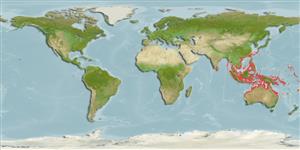Common names from other countries
Teleostei (teleosts) >
Acanthuriformes (Surgeonfishes) >
Siganidae (Rabbitfishes)
Etymology: Siganus: Latin, siganus = a fish, rabbit fish; by the similarity of the nose (Ref. 45335).
More on authors: Evermann & Seale.
Environment: milieu / climate zone / depth range / distribution range
Ecology
Marine; reef-associated; depth range ? - 30 m (Ref. 58652), usually 1 - 30 m (Ref. 27115). Tropical; 30°N - 30°S
Western Pacific: Ryukyu Islands, the Philippines, and the North West Shelf, Western Australia.
Size / Weight / Age
Maturity: Lm ? range ? - ? cm
Max length : 20.0 cm SL male/unsexed; (Ref. 1419)
Dorsal spines (total): 13; Dorsal soft rays (total): 10; Anal spines: 7; Anal soft rays: 9; Vertebrae: 13. Color the same as in S. vulpinus except for the blackish spot posteriorly on the upper side of the body. Caudal peduncle only slightly incised. Spines stout, pungent, and venomous. Preopercular angle 109°-119°. Variable cheek squamation; usually covered with scales, 7-10 rows deep below center of orbit, occasionally a few scattered scales present below eye; a triangular area from lower edge of orbit to angle of mouth always fully scaled. Fully scaled midline of thorax.
Inhabits rich coral areas of lagoons and outer reefs, often among staghorn corals (Ref. 90102). Small juveniles occur in schools of up to a few hundred fish, larger juveniles and adults occur in pairs. Feeds on seaweeds (Ref. 9813).
Life cycle and mating behavior
Maturities | Reproduction | Spawnings | Egg(s) | Fecundities | Larvae
Woodland, D.J., 1990. Revision of the fish family Siganidae with descriptions of two new species and comments on distribution and biology. Indo-Pac. Fish. (19):136 p. (Ref. 1419)
IUCN Red List Status (Ref. 130435)
CITES (Ref. 128078)
Not Evaluated
Threat to humans
Venomous
Human uses
Fisheries: commercial; aquarium: commercial
Tools
Special reports
Download XML
Internet sources
Estimates based on models
Preferred temperature (Ref.
115969): 25.4 - 29.1, mean 28.2 (based on 1226 cells).
Phylogenetic diversity index (Ref.
82804): PD
50 = 0.5000 [Uniqueness, from 0.5 = low to 2.0 = high].
Bayesian length-weight: a=0.01445 (0.00650 - 0.03213), b=3.08 (2.90 - 3.26), in cm Total Length, based on LWR estimates for this Genus-body shape (Ref.
93245).
Trophic level (Ref.
69278): 2.7 ±0.30 se; based on food items.
Resilience (Ref.
120179): High, minimum population doubling time less than 15 months (Preliminary K or Fecundity.).
Fishing Vulnerability (Ref.
59153): Low vulnerability (14 of 100).
